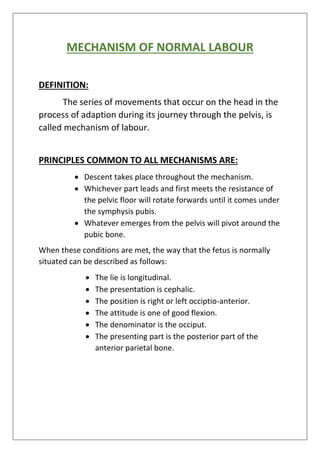
MECHANISM OF NORMAL LABOUR.docx
- 1. MECHANISM OF NORMAL LABOUR DEFINITION: The series of movements that occur on the head in the process of adaption during its journey through the pelvis, is called mechanism of labour. PRINCIPLES COMMON TO ALL MECHANISMS ARE: Descent takes place throughout the mechanism. Whichever part leads and first meets the resistance of the pelvic floor will rotate forwards until it comes under the symphysis pubis. Whatever emerges from the pelvis will pivot around the pubic bone. When these conditions are met, the way that the fetus is normally situated can be described as follows: The lie is longitudinal. The presentation is cephalic. The position is right or left occiptio-anterior. The attitude is one of good flexion. The denominator is the occiput. The presenting part is the posterior part of the anterior parietal bone.
- 2. MAIN MOVEMENTS: 1. DESCENT: Descent of the fetal head into the pelvis often begins before the onset of labour. In primigravidae it usually occurs during the later weeks of pregnancy when engagement of the head provides confirmation that vaginal delivery is probable. In multigravidae muscle tone is lax and therefore engagement
- 3. may not occur until labour actually begins. Throughout the first stage of labour the forces of contraction and retraction aid descent. Following rupture of forewaters and full dilatation of the cervix, maternal effort speeds progress. 2. FLEXION: This increases throughout labour. The fetal spine is attached nearer the posterior part of the skull; pressure exerted down the fetal axis will be more forcibly transmitted to the occiput than the sinciput. The effect is to increase flexion which results in smaller presenting diameters which will negotiate the pelvis more easily. At the onset of labour, the suboccipito-frontal diameter, 10 cm , is presenting, with greater flexion the suboccipitobregmatic diameter , 9.5 cm, presents. The occiput becomes the leading part. 3. INTERNAL ROTATION OF THE HEAD : During a contraction the leading part is driven downwards onto the pelvic floor. The slope of the pelvic floor determines the direction of rotation. The muscles are gutter- shaped and slope down anteriorly, so whichever part of the fetus first meets the lateral half of this slope will be directed forwards and towards the center. In a well flexed vertex presentation, the occiput leads and meets the pelvic floor first and rotates anteriorly through one-eight of a circle. This causes a slight twist in the neck of the fetus as the head is no longer in direct alignment with the shoulders. The anteroposterior diameter of the head now lies in the widest(anteroposterior) diameter of the pelvic outlet, facilitating an essay escape.
- 4. 4. CROWNING: The occiput slips beneath the sub-pubic arch and crowning occurs when the head no longer recedes between contractions and the widest transverse diameter(biparietal)is born. If flexion is maintained, the suboccipitobregmatic diameter, 9.5 cm, distends the vaginal orifice. 5.EXTENSION OF THE HEAD: Once the crowning has occurred the fetal head can extend, pivoting on the suboccipital region around the pubic bone. This releases the sinciput, face and chin which sweep the perineum and are born by a movement of extension. The suboccipitofrontal diameter, 10 cm, distends the vaginal outlet. 6.RESTITUTION: The twist in the neck of the fetus which resulted from internal rotation, is now corrected by a slight untwisting movement. The occiput moves one-eighth of a circle towards the side from which it started. 7. INTERNAL ROTATION OF THE SHOULDERS: The shoulders undergo a similar rotation to that of the head to lie in the widest diameter of the pelvic outlet, namely anteroposterior. The anterior shoulder is the first to reach the levator ani muscle and therefore rotates anteriorly to lie under the symphysis pubis. This movement can be clearly seen as the head
- 5. turns at the same direction as restitution and the occiput of the fetal head now lies laterally. 8. LATERAL FLEXION: The shoulders are born sequentially. The anterior shoulder slips beneath the sub-pubic arch and the posterior shoulder passes over the perineum. This enables a smaller diameter to distend the vaginal orifice than if both shoulders were born simultaneously. The remainder of the body is born by lateral flexion as the spine bends sideways through the curved birth canal. PREPARED BY: Deepika Dorjee Pema Thungon Gireesha.B.S J. Evlin Petescia J. Kavyashree Joshmila Mutum Joy Hait Kartik Bhandari Mahima Susan Ajith Mamata Jadhav